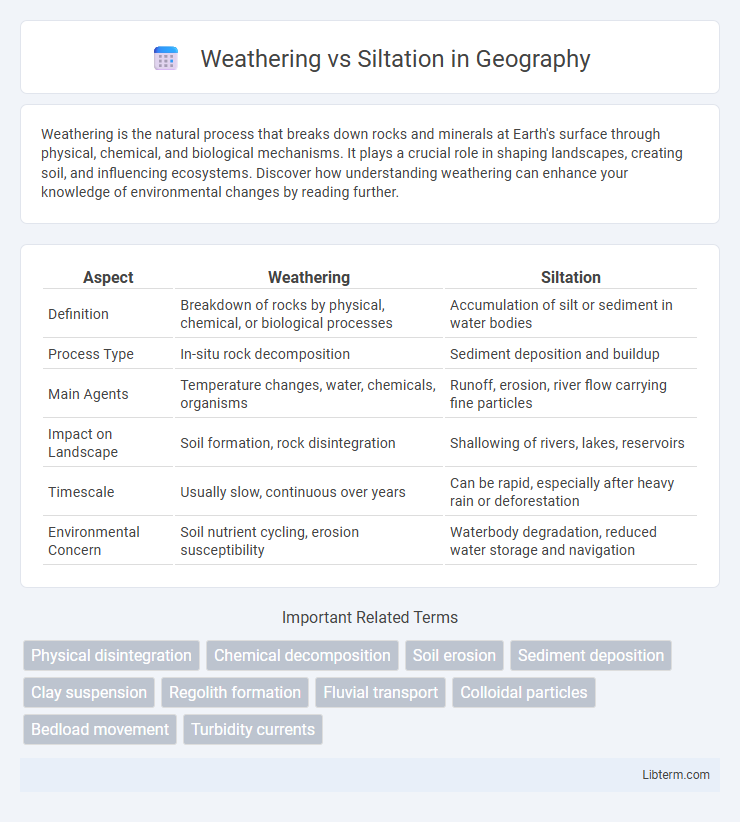Weathering is the natural process that breaks down rocks and minerals at Earth's surface through physical, chemical, and biological mechanisms. It plays a crucial role in shaping landscapes, creating soil, and influencing ecosystems. Discover how understanding weathering can enhance your knowledge of environmental changes by reading further.
Table of Comparison
| Aspect | Weathering | Siltation |
|---|---|---|
| Definition | Breakdown of rocks by physical, chemical, or biological processes | Accumulation of silt or sediment in water bodies |
| Process Type | In-situ rock decomposition | Sediment deposition and buildup |
| Main Agents | Temperature changes, water, chemicals, organisms | Runoff, erosion, river flow carrying fine particles |
| Impact on Landscape | Soil formation, rock disintegration | Shallowing of rivers, lakes, reservoirs |
| Timescale | Usually slow, continuous over years | Can be rapid, especially after heavy rain or deforestation |
| Environmental Concern | Soil nutrient cycling, erosion susceptibility | Waterbody degradation, reduced water storage and navigation |
Introduction to Weathering and Siltation
Weathering involves the physical, chemical, and biological processes that break down rocks and minerals at or near the Earth's surface, producing sediments that contribute to soil formation. Siltation refers to the accumulation of fine sediment, mainly silt and clay, in water bodies, often resulting from erosion and weathering activities. Both processes significantly impact landscape evolution, soil fertility, and aquatic ecosystems by altering sediment distribution and water quality.
Defining Weathering: Processes and Types
Weathering refers to the natural processes that break down rocks and minerals at or near the Earth's surface through mechanical, chemical, and biological means. Mechanical weathering physically fragments rocks without altering their chemical composition, while chemical weathering involves the transformation of minerals through reactions with water, oxygen, and acids. Biological weathering occurs when organisms such as plants and microbes enhance rock decay through physical disruption or chemical secretion.
What is Siltation? Causes and Mechanisms
Siltation refers to the accumulation of fine sediment, primarily silt and clay particles, in water bodies such as rivers, lakes, and reservoirs. It is caused by the erosion of soil due to rainfall, deforestation, agricultural activities, and construction, which transports sediment into aquatic environments through surface runoff. The mechanisms of siltation involve sediment deposition driven by decreased water velocity and flocculation, leading to reduced water depth, habitat disruption, and impaired water quality.
Key Differences: Weathering vs Siltation
Weathering is the natural process of breaking down rocks and minerals through physical, chemical, or biological means, resulting in soil and sediment formation. Siltation refers to the accumulation and deposition of fine particles, primarily silt, in water bodies, often caused by erosion and runoff. While weathering generates sediments from bedrock, siltation involves the transport and settling of these particles, impacting aquatic ecosystems and water quality.
Natural Factors Influencing Weathering
Natural factors influencing weathering include climate, rock type, and topography, which determine the rate and extent of physical and chemical breakdown of rocks. Temperature fluctuations cause expansion and contraction, leading to physical weathering, while precipitation promotes chemical reactions with minerals. Biological activity also plays a significant role by producing organic acids that accelerate mineral decomposition during weathering processes.
Human Activities Driving Siltation
Human activities such as deforestation, mining, urban development, and agriculture significantly accelerate siltation by increasing soil erosion and sediment runoff into water bodies. Construction projects and poor land management disturb the natural soil structure, causing excessive deposition of sediments that degrade aquatic ecosystems and reduce water quality. This intensified siltation disrupts habitats, impairs water flow, and exacerbates flooding risks.
Environmental Impacts of Weathering
Weathering breaks down rocks and minerals, releasing essential nutrients like calcium and potassium into soil and water systems, which supports plant growth and maintains ecosystem health. Chemical weathering can also lead to acidification of soils and water bodies, disrupting aquatic life and vegetation. Physical weathering increases sediment availability, which may alter habitats but generally promotes soil formation necessary for sustaining terrestrial ecosystems.
Consequences of Siltation on Ecosystems
Siltation disrupts aquatic ecosystems by smothering habitats, reducing light penetration, and decreasing oxygen levels, which impairs photosynthesis and harms fish and invertebrate populations. It accelerates sediment accumulation in reservoirs and rivers, leading to reduced water storage capacity and altered flow regimes. These changes degrade biodiversity, impair water quality, and increase vulnerability to flooding and drought in affected ecosystems.
Prevention and Mitigation Strategies
Effective prevention of weathering involves stabilizing soil through vegetation cover and employing erosion control measures, such as mulching and terracing, to reduce surface runoff. Siltation mitigation requires sediment retention techniques like sediment basins, buffer strips, and controlled drainage systems to capture suspended particles before they reach water bodies. Integrating land management practices with regular monitoring helps minimize the environmental impact of both weathering and siltation on aquatic ecosystems.
Conclusion: Addressing Weathering and Siltation Challenges
Addressing weathering and siltation challenges requires integrated watershed management practices that reduce soil erosion and sediment transport. Implementing soil conservation techniques, such as afforestation and contour plowing, minimizes weathering impacts and controls silt deposition in water bodies. Continuous monitoring and sustainable land use planning are essential to mitigate the long-term environmental and economic effects of both processes.
Weathering Infographic

 libterm.com
libterm.com